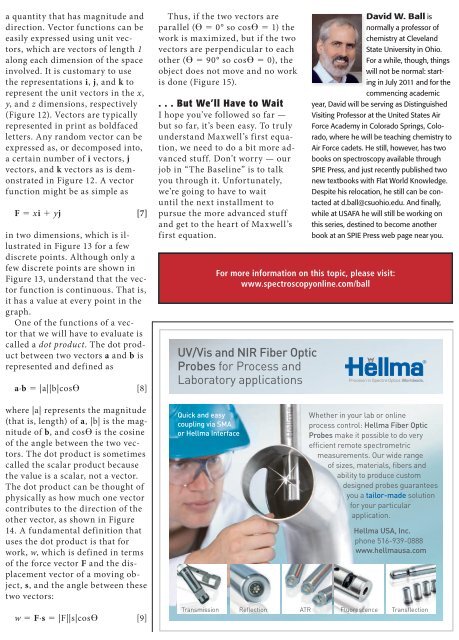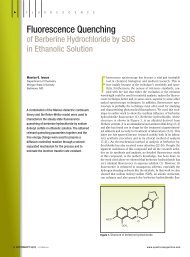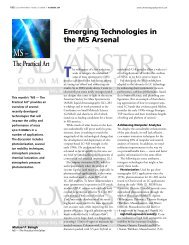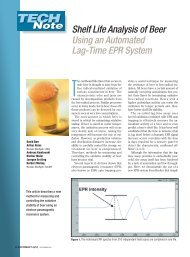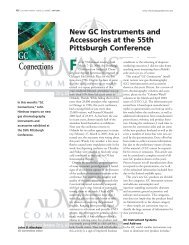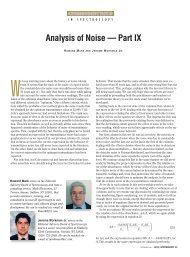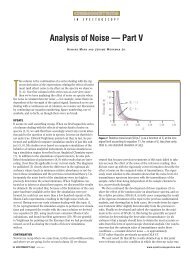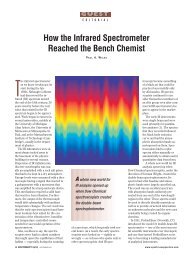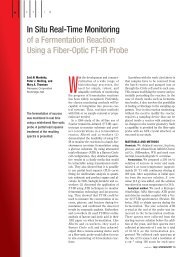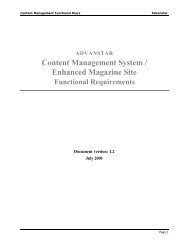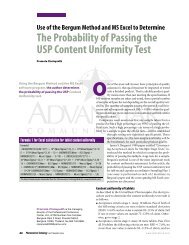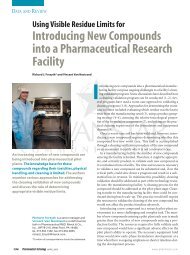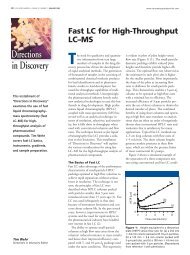Experimental - Spectroscopy
Experimental - Spectroscopy
Experimental - Spectroscopy
You also want an ePaper? Increase the reach of your titles
YUMPU automatically turns print PDFs into web optimized ePapers that Google loves.
www.spectroscopyonline.com June 2011 <strong>Spectroscopy</strong> 26(6) 21<br />
a quantity that has magnitude and<br />
direction. Vector functions can be<br />
easily expressed using unit vectors,<br />
which are vectors of length 1<br />
along each dimension of the space<br />
involved. It is customary to use<br />
the representations i, j, and k to<br />
represent the unit vectors in the x,<br />
y, and z dimensions, respectively<br />
(Figure 12). Vectors are typically<br />
represented in print as boldfaced<br />
letters. Any random vector can be<br />
expressed as, or decomposed into,<br />
a certain number of i vectors, j<br />
vectors, and k vectors as is demonstrated<br />
in Figure 12. A vector<br />
function might be as simple as<br />
F = xi + yj [7]<br />
in two dimensions, which is illustrated<br />
in Figure 13 for a few<br />
discrete points. Although only a<br />
few discrete points are shown in<br />
Figure 13, understand that the vector<br />
function is continuous. That is,<br />
it has a value at every point in the<br />
graph.<br />
One of the functions of a vector<br />
that we will have to evaluate is<br />
called a dot product. The dot product<br />
between two vectors a and b is<br />
represented and defined as<br />
a∙b = |a||b|cosϴ [8]<br />
Thus, if the two vectors are<br />
parallel (ϴ = 0° so cosϴ = 1) the<br />
work is maximized, but if the two<br />
vectors are perpendicular to each<br />
other (ϴ = 90° so cosϴ = 0), the<br />
object does not move and no work<br />
is done (Figure 15).<br />
. . . But We’ll Have to Wait<br />
I hope you’ve followed so far —<br />
but so far, it’s been easy. To truly<br />
understand Maxwell’s first equation,<br />
we need to do a bit more advanced<br />
stuff. Don’t worry — our<br />
job in “The Baseline” is to talk<br />
you through it. Unfortunately,<br />
we’re going to have to wait<br />
until the next installment to<br />
pursue the more advanced stuff<br />
and get to the heart of Maxwell’s<br />
first equation.<br />
For more information on this topic, please visit:<br />
www.spectroscopyonline.com/ball<br />
UV/Vis and NIR Fiber Optic<br />
Probes for Process and<br />
Laboratory applications<br />
David W. Ball is<br />
normally a professor of<br />
chemistry at Cleveland<br />
State University in Ohio.<br />
For a while, though, things<br />
will not be normal: starting<br />
in July 2011 and for the<br />
commencing academic<br />
year, David will be serving as Distinguished<br />
Visiting Professor at the United States Air<br />
Force Academy in Colorado Springs, Colorado,<br />
where he will be teaching chemistry to<br />
Air Force cadets. He still, however, has two<br />
books on spectroscopy available through<br />
SPIE Press, and just recently published two<br />
new textbooks with Flat World Knowledge.<br />
Despite his relocation, he still can be contacted<br />
at d.ball@csuohio.edu. And finally,<br />
while at USAFA he will still be working on<br />
this series, destined to become another<br />
book at an SPIE Press web page near you.<br />
where |a| represents the magnitude<br />
(that is, length) of a, |b| is the magnitude<br />
of b, and cosϴ is the cosine<br />
of the angle between the two vectors.<br />
The dot product is sometimes<br />
called the scalar product because<br />
the value is a scalar, not a vector.<br />
The dot product can be thought of<br />
physically as how much one vector<br />
contributes to the direction of the<br />
other vector, as shown in Figure<br />
14. A fundamental definition that<br />
uses the dot product is that for<br />
work, w, which is defined in terms<br />
of the force vector F and the displacement<br />
vector of a moving object,<br />
s, and the angle between these<br />
two vectors:<br />
Quick and easy<br />
coupling via SMA<br />
or Hellma Interface<br />
Whether in your lab or online<br />
process control: Hellma Fiber Optic<br />
Probes make it possible to do very<br />
efficient remote spectrometric<br />
measurements. Our wide range<br />
of sizes, materials, fibers and<br />
ability to produce custom<br />
designed probes guarantees<br />
you a tailor-made solution<br />
for your particular<br />
application.<br />
Hellma USA, Inc.<br />
phone 516-939-0888<br />
www.hellmausa.com<br />
w = F∙s = |F||s|cosϴ [9]<br />
Transmission Reflection ATR Fluorescence Transflection


